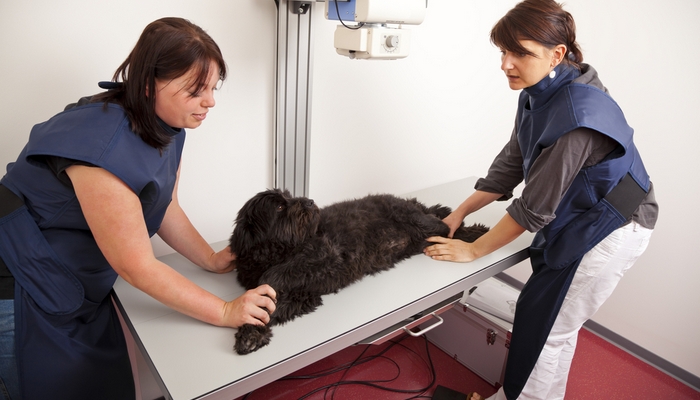 Knee injuries are quite common in humans. You've probably heard of a person tearing a ligament in their and needing surgery to repair it. Did you know that this same issue can happen to canines? ACL injuries in dogs are actually the number one orthopedic disease faced by canines.
Knee injuries are quite common in humans. You've probably heard of a person tearing a ligament in their and needing surgery to repair it. Did you know that this same issue can happen to canines? ACL injuries in dogs are actually the number one orthopedic disease faced by canines.
This week I had the pleasure of speaking with Dr. Neil Embleton, co-inventor of the Simitri Stable in Stride®, an implant that is revolutionizing the repairing of ACL ligaments in dogs. He worked with Dr. Veronica Barkowski to create the device.
Dr. Embleton wanted to be sure to acknowledge the incredible work done by Dr. Barkowski. She was able to determine exactly where to place the implant in the live patient based on measurements taken from preoperative radiographs.
An ACL repair can leave a dog needing physical therapy and weeks of rest and relaxation to heal properly. How do I know this? Because, sadly, my parents have three Labrador retrievers and two of them have undergone this surgery. I wish I had spoken with Dr. Embleton years ago, so I could have passed this knowledge on to my parents.
What is Simitri Stable?
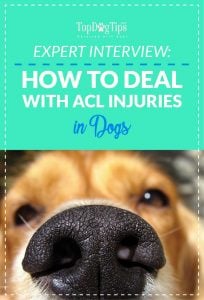 The Simitri Stable in Stride® is a surgical stabilization technique in which no bones or muscles are cut.
The Simitri Stable in Stride® is a surgical stabilization technique in which no bones or muscles are cut.
This is the key difference between this implant and the traditional surgical procedure for repairing ACL injuries in dogs. The Simitri Stable in Stride® technique utilizes a three-part modular implant that is positioned on the inside of the leg but remains outside the joint.
Don't worry, I know this all sounds like a bunch of veterinary jargon right now, but I'll explain it all in layman's terms! I spoke with Dr. Embleton to get some more information on what the implant is and why it is so revolutionary in the veterinary field.
For more in-depth information on the implant itself, you can check out New Generation Devices, the company that manufactures and distributes the implant. While this is a Canadian invention, Dr. Embleton says it is a true North American collaboration and he would like to thank New Generation Devices for their support.
READ ALSO: Dog Agility Competitions – How to Start, Risks, Injuries
How to Deal With ACL Injuries in Dogs
(Expert Interview)
So first, you're probably wondering what Dr. Embleton's credentials are. He graduated from the Ontario Veterinary College in 1987, and his career in the veterinary field began in mixed animal practice in Southern Ontario. After a year of that, he and his wife migrated to Alberta and towards small animal surgery, especially orthopedics.
Dr. Embleton told me that he enjoyed the challenge of putting the pieces back together after an orthopedic injury. Sadly, due to a lack of funds and having a young family, an orthopedic surgical residency was not an option for him at the time. Instead, he has pursued many continuing education courses over the last 29 years.
He is certified in AO/ASIF techniques, spinal surgery, arthroscopy, TPLO (another common ACL repair technique) and total hip replacement. In fact, Dr. Embleton performed the first canine cemented total hip replacement procedure in Alberta.
So, why such a focus on ACL injuries in dogs?
RELATED: 7 Tips for Saving Money on Vet Bills
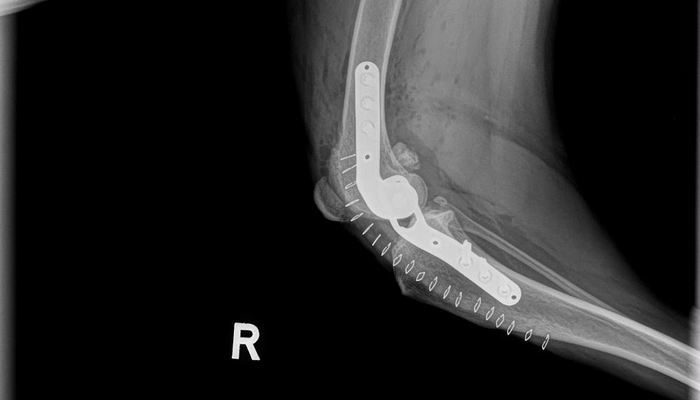
What are ACL injuries in dogs?
Before we can talk about the Simitri Stable in Stride®, we need to understand exactly why it is needed in the first place. There are four ligaments that stabilize your dog's knee during movement. The cranial cruciate ligament, referred to as the anterior cruciate ligament or ACL in humans, is the main stabilizer of the knee joint.
This ligament has two main functions:
It limits cranial translation and internal rotation of the tibia, otherwise known as forward and inward rotation movement of the shin.
As the ligament fails, the knee becomes unstable. This leads to pain, lameness and arthritis, loss of range of motion and decreased muscle mass of the affected leg. Dr. Embleton says that the incidence of the disease varies, with some breeds being more susceptible. On average it affects about 3-5% of the canine population, and he told me that it is the number one orthopedic disease faced by dogs.
Breeds that are more susceptible to ACL injuries in dogs include:
- Labrador retrievers
- Newfoundlands
- German shepherds
- Rottweilers
- Golden retrievers
RELATED: 8 Resources for Choosing the Best Veterinarian
What other options are available?
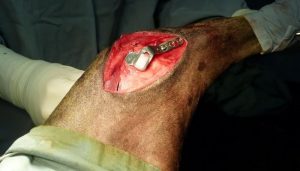 Currently, there are two main classes of surgical management of cruciate ligament injuries: extracapsular repair techniques using either monofilament nylon or multifilament braided material to emulate the ligament, or geometry modifying procedures such as TPLO.
Currently, there are two main classes of surgical management of cruciate ligament injuries: extracapsular repair techniques using either monofilament nylon or multifilament braided material to emulate the ligament, or geometry modifying procedures such as TPLO.
Over time Dr. Embleton began to question the procedure itself. He says he had issues with inflicting a hard tissue injury (cutting a healthy bone) and forever changing the biomechanics of the dog's knee joint.
There is still no scientific evidence to suggest one procedure has benefits over another. – Dr. Neil Embleton
He began to think about what the role of the cranial cruciate ligament was and how he could reproduce its function and maintain joint biomechanics while being as minimally invasive as possible. Dr. Embleton explained that this process began 6 years ago – the result was the Simitri Stable in Stride® implant.
RECOMMENDED: Holistic Dog Health 101 – Ultimate Sciene-based Guide
How does it work?
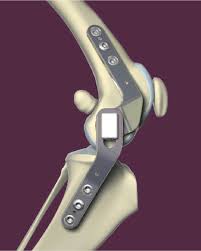
The Simitri Stable in Stride® implant is a three part, modular knee stabilizing implant that is designed to provide immediate and continuous translational and rotational stability while minimally affecting movement.
The implant consists of surgical grade femoral and tibial plates and an ultra high molecular weight polyethylene sliding articulating insert.
The polyethylene is the same material used in hip and knee replacements in humans. The femoral plate has a ball and stem, which interconnects with the tibial plate via an 8 mm travel channel within the articulating insert.
The implant is attached to the inner side of both the femur (thigh) and tibia (shin) using six cortical locking screws. The implant does not go into the joint, and no bones or muscles are cut during the procedure making it a much less invasive option.
Unlike currently available procedures, joint biomechanics are not significantly altered during the procedure.
Once implanted the Simitri Stable in Stride® provides immediate and continuous translational and rotational stability while also allowing the joint the freedom to flex, extend, compress, expand and move side to side in as normal a manner as possible.
When I asked Dr. Embleton about the post-op recovery compared to other methods, and this is what he had to say:
“Like night and day.” Exact quote from several clients who had a TPLO procedure first and then experienced a Simitri Stable in Stride procedure and to be perfectly honest it's the same sentiment expressed by veterinary clinics dealing with Simitri patients for the first time. The procedure is so much less invasive and provides continuous stifle (knee joint) stability, this makes it a significantly less painful surgical procedure. Unlike current procedures, Simitri patients are expected to go for an unsupported short (5-10 minute) walk the day they go home.” – Dr. Neil Embleton
Like all other treatments for ACL injuries in dogs, the rehabilitation process isn't easy and it isn't quick. Dr. Embleton told me that the Simitri Stable in Stride rehabilitation process begins the day after surgery, with most of the patients recovered within two to three months.
He explained that the chief engineer for New Generation Devices did a very thorough mechanical testing of the implant. This testing showed that when used in the appropriately sized patient, the implant should last the lifetime of the patient.
However, as this is a new procedure the longest follow up so far is 3 years.
READ ALSO: 18 Tips on How to Save Money on Dog Care
Possible complications
With any surgical procedure there are potential complications, and Dr. Embleton says that although we can compare rates of complications, it is also important to compare the types of complications.
Because the Simitri Stable in Stride® procedure is less invasive, the complications are less serious as compared to the other procedures, especially those that require an osteotomy (cutting of bone).
Dr. Embleton told me that in a scientific paper on the first 66 cases (which they have had accepted for publication), complications were broken into two categories: major and minor. Major complications are ones requiring a revision surgery, minor require no treatment or medical management.
They reported a major complication rate of 15% and a minor complication rate of 11%.
This is comparable to the complication rates of current procedures, but again the types of complications were significantly different and mostly the result of using the implant in too large a dog.
As a result of that clinical trial, changes were made to both the procedure and the implant itself. Dr. Embleton says the current major complication rate is now below 6%, and the minor complication rate is 2%.
This is the lowest complication rate of any of the current cruciate repair procedures.
RELATED: 25 Most Serious Dog Health Symptoms That Cannot Be Ignored
When Dr. Embleton became a veterinarian, he promised his mother that he would make a difference in the well being of animals. Even though she passed away four years ago, and has never seen the Simitri Stable in Stride implant, he sure that she is watching over him and would be proud of what he has done. This implant is revolutionizing the repair of ACL injuries in dogs, and it will definitely benefit countless dogs in the future.
Dr. Embleton wanted to make sure that I mentioned that he is happy to help any veterinarian learn this procedure and that all the teaching information is available on line.
I’d like to take this time to thank Dr. Neil Embleton for speaking with me about his amazing implant. Make sure you check out New Generation Devices for more information about the Simitri Stable in Stride® and how it may be able to help pets suffering with ACL injuries in dogs.
READ NEXT: 17 Tips on How to Choose the Best Dog Food for Your Dog


